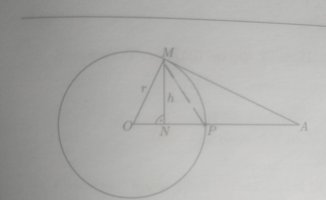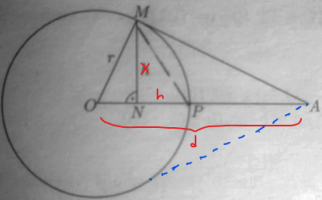Official problem formulation:
Calculate the part of the surface of a sphere which is seen from point A if the radius of the sphere is r, and the distance between point A and the center of the sphere is d ( d > r ).
The confusion on my part pertains to 2 things, which I will note below.
First comes with the official visualization of the problem presented on the picture below. Why is A not defined as the intersection of 2 tangent lines on the circle ? This was my first intuitive assumption ( possibly derived from analytic geometry, but also quite logical when I think about the way humans see things, in their whole ) ), but it ended up being false, as shown below. Why ?
The official solution then proceeds to utilize similarity of triangles OAM and ONM in the following manner:
[math]\frac{ON}{OM} = \frac{OM}{OA}[/math][math]ON = \frac{OM^2}{OA} = \frac{r^2}{d}[/math]
Now comes the second confusing part for me.
The official solution now says ( with no explanation ) that:
[math]h = NP = OP - ON = r - \frac{r^2}{d} = r(1 - \frac{r}{d} )[/math]
I don't at all understand how they concluded that h equals NP. I assume it is related to the face OPM is an isosceles triangle ( because OP and OM are both radii of the sphere ), but I cannot determine exactly how h = NP is deduced from this fact.
Any help would be highly appreciated.
Calculate the part of the surface of a sphere which is seen from point A if the radius of the sphere is r, and the distance between point A and the center of the sphere is d ( d > r ).
The confusion on my part pertains to 2 things, which I will note below.
First comes with the official visualization of the problem presented on the picture below. Why is A not defined as the intersection of 2 tangent lines on the circle ? This was my first intuitive assumption ( possibly derived from analytic geometry, but also quite logical when I think about the way humans see things, in their whole ) ), but it ended up being false, as shown below. Why ?
The official solution then proceeds to utilize similarity of triangles OAM and ONM in the following manner:
[math]\frac{ON}{OM} = \frac{OM}{OA}[/math][math]ON = \frac{OM^2}{OA} = \frac{r^2}{d}[/math]
Now comes the second confusing part for me.
The official solution now says ( with no explanation ) that:
[math]h = NP = OP - ON = r - \frac{r^2}{d} = r(1 - \frac{r}{d} )[/math]
I don't at all understand how they concluded that h equals NP. I assume it is related to the face OPM is an isosceles triangle ( because OP and OM are both radii of the sphere ), but I cannot determine exactly how h = NP is deduced from this fact.
Any help would be highly appreciated.


